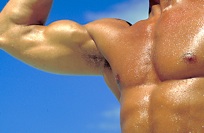Module 2 Topic A:
Power, Sport, and Masculinities
Module 2 Topic A:
Power, Sport, and Masculinities

1. LECTURE
For six slides per page format (for printing) click : HERE
For one slide per page format (for viewing on computer) click: HERE
2. VIDEO CLIPS
These video clips, unless otherwise advised, will be shown during lecture. They are made available here for revision purposes.
Video Clip 1: Judith Butler (2011) speaking on issues related to gender performance and performativity.
Video Clip 2: The rousing half-time speech at a minor league Australian Rules football game (WARNING: Bad Language alert!).
Video Clip 3: A clip from The IT Crowd, demonstrating the learned nature of masculine performance, particularly related to sport spectating.
Video Clip 4: “I’m Good” Pepsi Max commercial, illustrating the performative nature of masculinity.
Video Clip 5: MTV feature on the development of the instrumental football body.
Video Clip 6: MTV feature on the development of the professional oriented bodybuilder’s body.
Video Clip 7: The Tough Guy Race, more examples of performative masculinities.
Video Clip 8: Promotion for an UFC computer game, illustrating the commercial media’s representation of violent masculinity.
Video Clip 9: MTV feature on the development of the cosmetically manufactured body (WARNING: Surgical procedure alert!).
Video Clip 10: An excerpt from an episode of Frasier, highlighting the changed relationship between the exercising body and sexuality.
Video Clip 11: An excerpt from the movie Murderball, and the performance of masculinity by those with physically-challenged bodies.
3. REQUIRED READINGS
It is expected that you will complete these readings prior to the discussion sections, and that–where appropriate–your engage them within your classroom discussion.
4. THEMATIC REVIEW QUESTIONS
Given the volume of information provided in the classroom, you are strongly advised not to engage the material solely during lectures.
Rather, you are strongly encouraged to review each theme carefully on your own, following which you should test your knowledge and understanding by answering the Thematic Review Questions which can be accessed HERE.
5. KEY CONCEPTS
The following key concepts represent the core knowledge related to this topic, and you should ensure that you develop a thorough knowledge and understanding of them before moving on to the next topic:
De-Naturalizing the Gendered/Sexed Body
The Social and Cultural Construction of the Body
Sex and Gender Classifications
Gender Performance and Performativity
The Hierarchical Gender Binary
Patriarchy and Patriarchal Institutions
The Corporeal Origins of Patriarchy
Sport as a Performative Gendered and Gendering Institution
The Embodied Bases of Masculinity
The Social and Cultural Construction of the Sporting/Active Body
Gendered Sporting Ideologies, Institutions, Practices, and Texts
The Hyper-Masculine Centre of American Sport Culture
Physicality and Masculinity
The Primary Sources of Masculinity
The Demands of Hyper-Masculine Sport Performance
The Triad of Sport-Related Violence
Sport, Masculinity, and the Fear of Social Rejection
Sport and Hegemonic Masculinity
The Process and Practice of Mosaic Masculinity
Instrumental, Professional, Exercising, and Representative Masculinities
The Homosexual and Able-Bodies Centres of Masculine Sport Culture
Emergent Sporting Masculinities
Cosmetic, Homosexual, and Adaptive Masculinities
6. DISCUSSION QUESTION/TASK #5
This question/task will be discussed in discussion sections on:
Monday, October 22
Wednesday, October 24
Men’s involvement in organized sport is both detrimental to themselves, to their immediate social relations, and to society more generally. As such, organized sport is in serious need of reform. Discuss this observation and any reform strategies you feel appropriate.
7. ESSAY QUESTION #5 (this is an option for the Module 2 essay)
According to Judith Butler (1995, p. 25, “There is not gender identity behind the expressions of gender;...identity is performatively constituted by the very ‘expressions’ that are said to be its results.”
Discuss the relevance of Butler’s observation for the understanding of the embodiment, experiencing, and effects of masculine performativity within sport and physical culture.
This essay should be a minimum of 1,500 words to answer it comprehensively.
You may find the following academic sources useful in completing this assignment. You do not have to use these sources, they are simply provided for you as an introduction to the literature, and you should use them where appropriate and/or relevant. Also, be warned, these readings do not count towards the THREE additional academic sources you are expected to use within your essays (however, they may direct you toward additional academic sources you could use).
If you choose to complete this essay, and in addition to the sources provided on this page, you need to identify and use (either through paraphrasing or direct quotation) interpretations, insights, or information from a MINIMUM OF THREE appropriate academic sources (in addition to those provided for you on this website).
The deadline for submitting your Module II Essay is before class on Sunday November 23. In order to receive feedback from your TA, you can submit a draft version of your essay up to and including Sunday November 16.
Important: The ELMS/Canvas website will not accept essays after the due time and date.
Be sure to review the details on the module essay page. On that page you will find the EVALUATION CRITERIA for module essays (which you are strongly encouraged to read), you will also find links to the appropriate academic sources you should use when researching and writing your module essays, and the style and format guidelines you need to follow when completing module essays. All this information needs to be read, understood, and closely followed for you to succeed in this course.
KNES 287
ONLINE
KNES 287